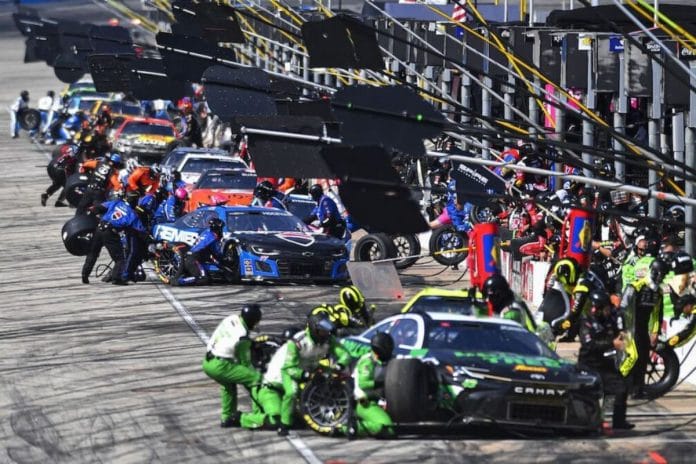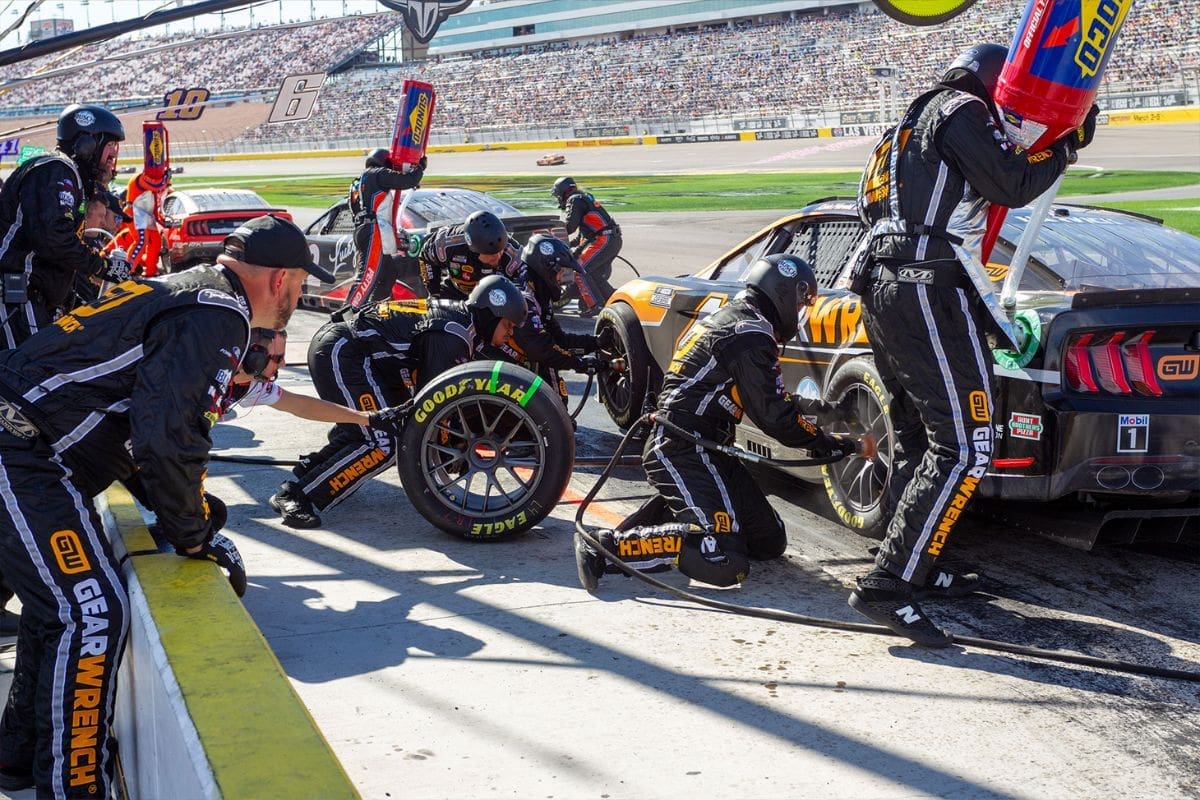NASCAR Teams Waste Millions on Tires: NASCAR teams, particularly Joe Gibbs Racing (JGR), contend with excessive tire expenses that greatly impact their operational budgets, with annual costs nearing $2.167 million. The challenge escalates as teams often face the dilemma of unused, non-refundable tires, leading to nearly a million dollars wasted each season. This financial strain not only affects immediate expenditures but also restricts investment in vehicle development—a critical aspect of competitive performance. As the racing industry grapples with these financial inefficiencies, the pressing question remains: what groundbreaking strategies can teams implement to mitigate waste and improve sustainability?
Key Highlights
- JGR’s total tire expenditure for a season approaches $2.167 million, highlighting the significant financial burden on NASCAR teams.
- Teams like JGR face nearly one million dollars in financial losses annually due to tire waste and inefficiencies in management.
- High tire costs force teams to adopt conservative race strategies to minimize consumption and maximize performance.
- Used tires are often discarded due to performance degradation, raising environmental concerns and increasing waste in the racing industry.
The High Cost of NASCAR Tires
How do the exorbitant costs of NASCAR tires impact team budgets and general race strategies? The financial burden of tire expenditure is a critical factor that shapes the operational dynamics of racing teams. With tire costs being one of the largest line items in a team’s budget, the allocation of resources becomes a delicate balancing act. Teams must tactically determine how many sets of tires to utilize during practice, qualifying, and the race itself, directly influencing their comprehensive performance.
The rapid wear and tear of tires at high speeds necessitates frequent replacements, compelling teams to invest heavily in quality materials that can endure the rigors of competition. This focus on durability and performance often drives up costs, forcing teams to prioritize tire management in their race strategies. The ability to conserve tires can be a game changer; teams that master this aspect can optimize their performance, potentially reducing pit stop frequency and enhancing overall race pace.
Furthermore, teams must analyze tire performance characteristics, such as grip and degradation rates, to inform their strategies effectively. As a result, the decision-making process becomes multifaceted, involving not only budgetary considerations but also real-time race conditions.
Fundamentally, the high costs associated with NASCAR tires not only strain financial resources but also compel teams to innovate and adapt their strategies, emphasizing the intricate interplay between economics and competitive racing.
Tire Costs per Joe Gibbs Racing
The financial impact of tire costs is particularly pronounced for Joe Gibbs Racing (JGR), where the inability to return unused tires for reimbursement greatly affects budget allocation and tactical planning for each race. Each weekend, JGR purchases tires from Goodyear, with costs accumulating regardless of usage. Denny Hamlin articulates this concern, noting that if the team receives eight sets of tires and uses only six, the remaining two are effectively wasted, as there is no rebate or refund for unused tires.
This non-refundable model places a considerable strain on JGR’s financial resources. With each set of tires representing a substantial investment, teams must carefully forecast tire usage based on track conditions, vehicle performance, and race strategy. However, the inherent unpredictability of racing often leads to mismatches between anticipated and actual tire usage, resulting in excess expenditure. This phenomenon not only strains the budget but also diverts funds from other critical areas such as crew development and technology improvement.
“Say we go to Texas this weekend and they give us eight sets of tires. If we use six, we don’t get a rebate on those two. We do not get reimbursed for those tires. If we have a leftover set, $2,400 a piece or whatever they might be, we can’t just turn them back into Goodyear and get a refund. They tell us ‘you’re buying these sets of tires and they’re yours now, you can do whatever you want with them.” – Hamlin
View this post on Instagram
The implications of tire costs extend beyond immediate financial concerns; they also influence tactical decisions. Teams may opt for conservative race strategies to minimize tire consumption, potentially compromising competitive performance. Therefore, the inability to recoup costs on unused tires creates a paradox where teams must balance financial prudence with the pursuit of victory, highlighting the complex dynamics of cost management in NASCAR racing.
Quantity of Tires Used and Costs
Analyzing the quantity of tires utilized throughout a NASCAR season reveals considerable financial implications for teams like Joe Gibbs Racing, particularly given the varying demands of different races. The Clash, for instance, necessitates only five sets of tires, while the prestigious Coke 600 requires a staggering 14 sets. These differences emphasize the need for teams to tactically manage tire inventory based on race specifications.
“Events such as the clash requires to have five sets of tires. While others such as the Coke 600 require us to have 14 sets. At this point in the year, we have had 24 race weekends, and our team has four cars. Each car needed 246 sets of tires, meaning our total of 985 sets, which is 3940 tires.” – jgr’s instagram post
With a total of 24 race weekends in a season and four cars per team, JGR’s tire requirements escalate dramatically. The team finds itself needing approximately 985 sets of tires, which translates to a staggering 3,940 individual tires. The financial burden of this extensive tire usage is substantial, as each set of tires costs around $550. Cumulatively, JGR’s tire expenditure for the season approaches $2.167 million.
This considerable investment raises critical questions regarding efficiency and waste management within the organization. Teams must not only account for the sheer volume of tires consumed but also consider the implications of tire performance and longevity. As each tire set is carefully engineered for specific conditions and race strategies, the challenge lies in optimizing tire usage without compromising competitive edge.
Fate of Used Tires
What happens to used tires after a race is a critical consideration for NASCAR teams, as aging and changes in rubber compounds render them unsuitable for future competitions. The integrity of tire performance is paramount in the high-stakes environment of NASCAR, where even minor lapses can affect race outcomes. Consequently, tires that have been used, particularly those with distinct date codes, are often deemed ineffective for future races.
Denny Hamlin, a notable driver, emphasizes this issue, stating that while tires may be placed in inventory post-race, their efficacy diminishes over time. Specifically, tires that are several months old are typically not considered for competition, as their performance characteristics degrade considerably. This aging process is exacerbated by the unique demands of different tracks, which require ideal tire conditions to maintain a competitive edge.
“They’ll put them in inventory. Let’s say we go to Kansas next weekend, we likely would tap into that extra set and say ‘OK, we’re going to practice on those tires.’ But if Kansas is three, four months down the road we’re not going to want old date codes. We’re not going to want older tires because they age. Rubber ages and it changes compounds. It’s funny when you get older tires, that can really mess up a car. So it just goes to waste.” – Hamlin
The fate of these tires is largely one of disposal. NASCAR teams must contend with the reality that the majority of used tires will find their way to waste rather than reuse. This disposal not only reflects the environmental implications of tire waste but also highlights the inefficiencies inherent in tire management.
As teams navigate this complex landscape, the challenge remains to enhance tire usage while mitigating the financial and environmental costs associated with tire waste. Understanding the fate of used tires is crucial for teams aiming for competitive excellence while grappling with the broader implications of their operational practices.
Financial Impact of Tire Waste
Financial losses from tire waste represent a considerable challenge for NASCAR teams, with some organizations, like JGR, reporting expenditures nearing one million dollars on unused tires in a single season. This staggering figure not only reveals the financial strain placed on teams but also highlights the inefficiencies inherent in tire management within the sport. The costs associated with maintaining a tire inventory are substantial and can detract from funds that could otherwise be allocated to vehicle development or team operations.
How much JGR had an extra tire inventory in the first year of next-gen, 2022? How much money was spent and never ran? Nearly one million! Nearly one million dollars worth of tires, that JGR spent on tires that it never ran.” – Hamlin
The implications of tire waste extend beyond just immediate financial losses; they pose long-term sustainability concerns for NASCAR. As teams grapple with decreasing profit margins, the need for effective inventory management systems becomes critical. The current model, which often leads to excess procurement and subsequent waste, necessitates a reevaluation of practices surrounding tire usage and storage.
To mitigate these financial impacts, NASCAR could investigate groundbreaking strategies for tire reuse and recycling. Implementing a standardized, centralized tire distribution system may improve efficiency and reduce unnecessary expenditures. Furthermore, adopting more stringent guidelines for tire allocation based on race conditions could minimize overstocking.
Ultimately, addressing the financial impact of tire waste is vital for the economic viability of NASCAR teams. A concerted effort toward optimizing tire usage will not only alleviate financial burdens but also contribute to a more sustainable and responsible racing environment. The sport must adapt to these challenges to guarantee its continued growth and competitiveness in an evolving market.
News in Brief: NASCAR Teams Waste Millions on Tires
The financial burden of tire management within NASCAR, particularly for teams like Joe Gibbs Racing, highlights a pressing issue in the sport.
With annual expenditures exceeding $2 million and nearly $1 million wasted on unused tires, the inefficiencies not only deplete budgets but also stifle potential investments in vehicle development.
A tactical reevaluation of tire management practices is vital to mitigate waste and improve sustainability, ultimately benefiting both the teams and the broader environmental landscape of motorsports.
ALSO READ: NASCAR’s True Intentions Behind Blocking Foreign Investors, Insider Reveals a Hidden Agenda





